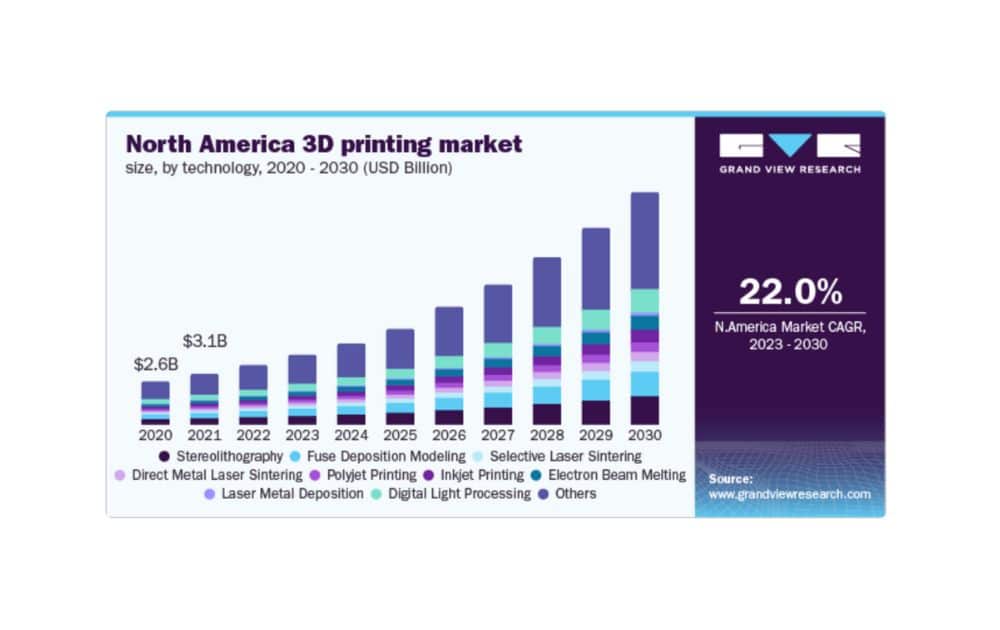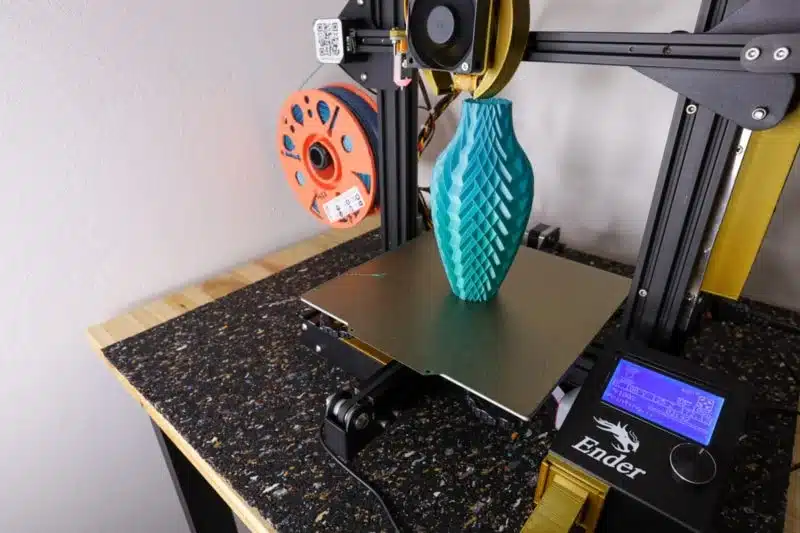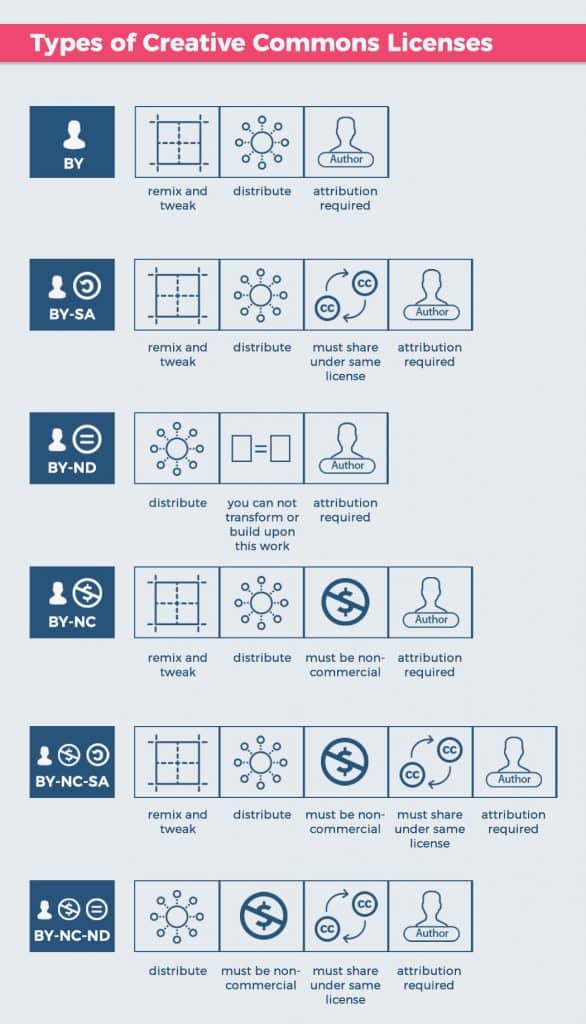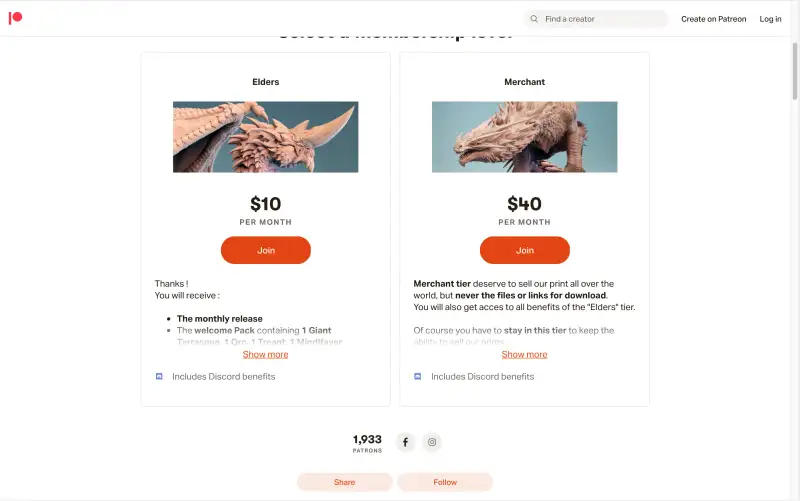Wondering how to sell 3D printed items and turn your cool 3D printing ideas into cash? Well, you’re not alone. Selling 3D-printed items is like hitting the jackpot in the world of DIY and creativity. It’s where your wildest designs come to life and might just fatten your wallet.
The 3D-printing market in North America was worth $3.1 billion in 2021. It’s also expected to expand rapidly, growing at a rate of 22% yearly from 2023 to 2030.
This growth is driven by intense research in 3D printing and a rising need for prototypes in several industries, especially healthcare, automotive, aerospace, and defense.

If you’re interested to find profitable market opportunities and ride the wave of 3D printing, it’s the perfect time to turn those creative projects into a business that rocks.
Whether you’re a 3D printing wizard or just starting to tinker, here’s the lowdown on making your mark and some cash as you sell 3D-printed items.
What are 3D Printed Items?
Before we dive deep into the topic of how to sell 3D-printed items, let’s first define what these products are.
As the name states, 3D-printed items are objects created by layering materials, typically plastic or resin, based on a digital model. It’s like a regular printer, but instead of ink on paper, it’s layers of material building up to form almost anything, from simple tools to complex models.It’s about creating a real-life object from a digital file. For example, many ventures sell 3D-printed items like figurines, home decor, jewelry, or even clothing.

All it takes is a 3D printer, which people can buy for personal use and 3D ink. This is a filament that you can feed into the printer.
Users program how the material is piled up until the final product is completed.
In short, 3D printing is like a small-scale manufacturing operation. But you don’t need a huge space to set it up. You can perform the whole process, known as fused deposition modeling (FDM), at home.
Why Sell 3D-Printed Items?
Without a doubt, FDM is a game-changer for creative entrepreneurs looking to enter the market of selling 3D-printed items. Here are a few benefits to enjoy if you decide to sell 3D-printed items:
- It takes little space and a few raw materials. With the proper modeling skills, you can design and create your items instantly. So, you can optimize your stock in real time.
- Speaking of stock, 3D printing does not require a lot of storage.
- Create a make-to-order approach to sell 3D-printed items without getting stuck with obsolete inventory. That means you can print each product as soon as customers order it. Once the item is done, you only need to pack and ship it.
That said, being able to sell 3D-printed items successfully takes time and research. For one, you need to invest in a 3D printer and working materials.
Don’t know where to sell 3D-printed items? Consider setting up a dedicated online store to showcase your products. Once this storefront is ready, you’ll need to create attractive listings and invest in advertising.
It’s also important to consider pricing, packing, shipping, and possibly partnering with fulfillment providers. Your final offer would cover the time and workplace spent creating each product. At the same time, it should allow you to make a reasonable profit.
However, perhaps the most important aspect is to hone your modeling skills or outsource the process to a seasoned creative. Doing so will allow you to sell unique products online, setting you apart in the crowded online marketplace.
Is it Legal to Sell 3D Printed Items?
Can you sell 3D-printed items legally? Yes, as long as you have the creator’s permission to do so. Let’s elaborate. Most 3D print designs online include a license type. For example:

You can usually make 3D-printed items that have IP protection for personal use only. But what if you want to change or sell? Here’s where Creative Commons may help.
These types of licenses state how you can use a creator’s work. Usually, you can get permission to use and share a design. In other instances, you can modify or even sell it.

That said, make sure you have permission to use and sell 3D-printed items that you make or choose. And if you’re a designer, always protect your work with an IP license. That’s how you can protect your brand and build a name that’s well-known by customers.
How to Sell 3D-Printed Items
Let’s review what it takes to sell 3D-printed items. We’ll focus on materials, resources, and practical knowledge.
Start-Up Materials
- 3D Printer. This is the key tool for your business, and there are many options to choose from. You can find decent printers between $250 to $500. Go for a model with high printing speed, build quality, and at least a 12×12-inch printing bed.
- 3D Ink. You’ll need a lot of this to print your models. Rolls usually retail between $20-30. Filaments come in various colors, gauges, and materials. You can find a few options here.
- Working tools. Pallet knives, nitrile gloves, and chemical sealant. You’ll need these items to work on your 3D models after printing. You can review some tool suggestions here.
- Modeling Software. If you’re a creator, you’ll need software to map your designs before printing. If that’s too much work, you can always browse around to find attractive 3D models for under $150.
- Work Computer. There’s no need for a big, powerful designer computer. That said, make sure your machine has over 4GB of RAM and 3D processing capabilities.
3D Printing
Nowadays, you can find many online tutorials and courses that teach you how to print 3D models. Here’s the overall process:
- Create your Models. Here, you have two options: sculpt your own models or work with a freelance designer to create original printing models.
- Download 3D designs. If you go for the second option, use models that feature a Creative Commons license. You can also contact the designer and ask permission to use their work.
- Program Your Printing. You’ll need a slicer program that translates the digital model into G-Code. This is key so the printer understands how you want to print a 3D model.
- Set Up the 3D Printer. Load the 3D in and make sure the printer bed is well positioned to take the filament in.
- Start Printing. The amount of time needed to print depends on the complexity of each model.
- Curate Your Designs. Here’s where you’ll need your assorted tools. You’ll need to sand mold lines, remove supports, and smooth out the 3D-printed item.
Tips for Selling 3D-Printed Items
Here are a few strategies to help you find success in the 3D printing market:
Identify Your Niche
Focusing on popular 3D-printed items to sell can be a good start, but finding a niche can set you apart. Whether it’s custom home decor, personalized gadgets, or even specialized tools, carving out your own space can lead to more targeted and successful selling.
Quality Over Quantity
Ensuring that your products are durable, well-designed, and meet customer expectations can lead to better reviews, repeat customers, and word-of-mouth referrals.
Utilize Multiple Sales Channels
Don’t limit yourself to just one platform, such as your website or brick-and-mortar store. The best place to sell 3D-printed items is often online marketplaces like Etsy, eBay, or Amazon, which offer a wide reach.
Is Selling 3D Printed Items Profitable?
When diving into the world of 3D printing, a key question often arises: Is selling 3D printed items profitable? The answer is a mix of yes and strategy.
It takes more than offering fancy items to have a successful business. Instead, try to zero in on 3D-printed items that sell and fill a need – objects that they can appreciate, use, or both.
Here are a few strategies to sell 3D-printed items and drive revenue:

- Offer Pre-made Prints. Think of home appliances, smartphone cases, vases, or planters. Select items that users buy on a regular basis. Doing so can help you build a steady sales flow and also attract repeat customers.
- Sell Your Own Designs. If you sell 3D-printed items that you designed, why not share the blueprints? One example is LordOfThePrint on Patreon, which is a popular designer focused on tabletop gaming 3D designs. You can charge a fee for templates, and users can then print them by themselves. It’s a great way to build your brand as a creator.
- Open a 3D Printing Locale. Market your services within your locality. For instance, you can help neighbors print new home decorations. Granted, this requires you to scale your operation and rely on automated processes. But the potential profits could be worth it.
- Rent Out Your 3D Printing Services. Offer your 3D printer to businesses that might benefit from it. Why not print custom office supplies for a business? You can also design souvenirs for a special event and collect a fee.
Final Thoughts
Not everyone may be keen on selling 3D-printed items. After all, there are legal and logistical issues to tackle to make it in this business.
But this market also features many niche audiences waiting for the right item – it’s not only about knowing what the best 3D-printed items to sell are, but getting them in front of the right audience.
While selling 3D printed items comes with its challenges, the potential rewards in this innovative and expanding market are indeed substantial.
Author





